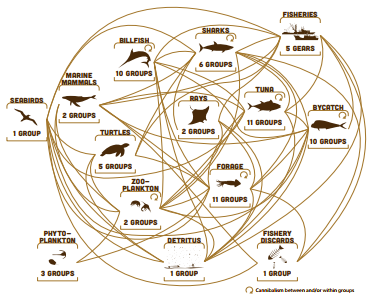Understanding the interactions between different components of the pelagic ecosystem to explore management options
Exploring and predicting the impact of environmental factors on fisheries ecosystems is of high importance to food security for the Pacific region. The models that we use to do this have been developed and improved over the years. Ecopath with Ecosim (EwE) is a model that is based on the food web: we assume that there is a steady state in this system so that the biomass is balanced (mass balance model). In this way, we can visualise the ecosystem and look at how this equilibrium can be influenced by fishing and environmental changes and explore management options.
This biodynamic trophic modelling approach provides a framework for the construction of mass-balance models of ecosystems. Modelling is based on estimates of how abundant the resources are (biomasses), the productivity or mortality rates of the resources, how they interact (diet compositions and food consumption rates), and how efficiently the resources are utilised in the ecosystem, including by fisheries. It needs data on the different components of the ecosystem and, central to the process of balancing the model, information on the diet matrix which tells us about the links between the species. EwE has the capacity to test different fishing policies and environmental change scenarios. The model allows us to visualise the ecosystem and it is a very useful learning tool to better apprehend the ecosystem and how it functions. By means of dynamic simulations it can help managers to identify the most robust and reliable management options that will achieve their objectives.

Several Ecopath models have been developed since 2002 for the warm pool in the western and central Pacific Ocean (WCPO), with improvements for each iteration. Some of the results of the models indicate:
- Increases in purse-seine fishing effort on FADs result in greater mortality of sharks, and in decreases in the biomass of some tuna species and size classes. Conversely, reductions in purse-seine fishing effort on FADs increase the numbers of sharks, although such benefits are not as pronounced when purse-seine fishing effort on FADs is transferred to purse-seine fishing on free schools of tuna. Increases in longline fishing result in greater mortality of sharks, opah, and some billfish species.
- Climate change and fishing effects interact. The ecosystem food web is sensitive to the synergistic effect of both factors, and for most species, climate change exacerbates the negative effect of any increase in fishing mortality.
- Long-lived species are particularly sensitive to climate change and fishing mortality.
- Climate change has a negative impact on edible bycatch species biomass with the strongest effects predicted after 2050.
